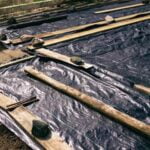Is pressure treated lumber safe for vegetable gardens? This article aims to delve into this question and shed light on the safety concerns surrounding the use of pressure treated lumber in vegetable gardens.
Pressure treated lumber is a common material used in gardening and construction, but its potential risks have raised concerns among gardeners and homeowners. By examining the chemicals used in pressure treated lumber and their impact on vegetable gardens, as well as understanding industry guidelines and regulations, this article will provide an informed perspective on the safety of using pressure treated lumber in your vegetable garden.
Pressure treated lumber is a type of wood that has been infused with preservatives to protect it against decay, insect damage, and fungal growth. These preservatives are typically made up of various chemicals, with one of the most commonly used being chromated copper arsenate (CCA). While pressure treated lumber may offer durability and longevity to structures like decks or fences, its potential impact on edible plants is a topic that deserves careful consideration.
The chemicals present in pressure treated lumber can leach into the soil over time, potentially coming into contact with plant roots and ultimately being absorbed into edible parts of vegetables. This raises concerns about the safety of consuming crops grown in close proximity to pressure treated lumber.
The potential health risks associated with exposure to these chemicals have prompted experts to advocate for caution when using pressure treated lumber in vegetable gardens. In the following sections, we will explore these risks in more detail while also considering the guidelines set forth by industry standards.
Understanding Pressure Treated Lumber
Pressure treated lumber is a type of wood that has been chemically treated to increase its durability and resistance against decay, insects, and moisture. The treatment process involves placing the lumber in a pressure cylinder where it is infused with chemicals under high pressure. This infusion process allows the chemicals to penetrate deep into the wood fibers, providing long-lasting protection.
The primary reason pressure treated lumber is used in construction and outdoor projects, including vegetable gardens, is its ability to withstand harsh weather conditions and prevent rotting. By protecting the wood from moisture and insect damage, pressure treated lumber can significantly prolong the lifespan of structures such as raised beds or trellises in vegetable gardens.
One of the most commonly used chemicals for treating lumber is chromated copper arsenate (CCA). CCA contains arsenic, which acts as a preservative against decay fungi and termites. However, due to concerns about the negative health effects of arsenic exposure, CCA-treated lumber has been phased out for residential use since 2004. Nowadays, other alternatives like alkaline copper quat (ACQ) or copper azole (CA) are typically used in pressure treated lumber for consumer applications.
Overall, understanding pressure treated lumber provides valuable insight into why it is widely used in vegetable gardens and outdoor projects. Its ability to resist decay and insect damage makes it a popular choice among gardeners looking for durable materials that can withstand the elements. However, it is essential also to consider potential risks associated with pressure treated lumber and take necessary precautions when using it in vegetable gardens.
The Potential Risks of Pressure Treated Lumber
Pressure treated lumber is a popular choice for building raised beds and other structures in vegetable gardens due to its durability and resistance to rot. However, it is essential to understand the potential risks associated with using pressure treated lumber in these settings. This section will delve into the chemicals used in pressure treated lumber and their impact on vegetable gardens.
One of the primary concerns regarding pressure treated lumber is the presence of chemicals such as arsenic, copper, and chromium. These chemicals are used to protect the wood against insects, decay, and rot. However, they can leach into the soil over time, potentially affecting the health of the plants and those consuming them.
Arsenic, in particular, has been a subject of concern when it comes to pressure treated lumber. It is a known carcinogen and can pose significant health risks if ingested or absorbed through the skin. While the levels of arsenic released from pressure treated lumber have decreased in recent years due to changes in regulations, there is still a possibility of exposure when using this type of wood in direct contact with soil.
To mitigate these risks, several safety guidelines should be followed when using pressure treated lumber in vegetable gardens. Firstly, it is advisable to line the interior sides of raised beds with plastic sheeting or landscape fabric to create a barrier between the soil and the wood. This prevents direct contact between plant roots and any leaching chemicals.
Additionally, it is crucial not to use pressure-treated wood where edible crops are directly grown or where there is frequent contact with bare skin. Instead, opt for non-toxic alternatives such as cedar or untreated pine for bed framing or use naturally rot-resistant materials like stone or concrete blocks.
By being aware of these potential risks and taking necessary precautions, gardeners can continue to enjoy the benefits of pressure treated lumber while minimizing any adverse effects on their vegetable gardens.
Safety Guidelines and Regulations
Pressure treated lumber is a popular choice for various outdoor construction projects, including vegetable gardens. However, with the potential risks associated with the chemicals used in pressure treated lumber, it is essential to understand the safety guidelines and regulations surrounding its use.
Regulatory Standards and Requirements
When it comes to pressure treated lumber, several regulatory bodies have established standards and requirements to ensure the safety of both consumers and the environment. The American Wood Protection Association (AWPA) sets industry standards for wood preservation, including pressure treated lumber. These standards outline important guidelines such as maximum allowable chemical retention levels, treatment methods, and information on proper handling.
In addition to the AWPA standards, national and local building codes may also provide regulations related to using pressure treated lumber in specific applications. It is crucial for gardeners using pressure treated lumber in vegetable gardens to be aware of these regulations and ensure compliance.
Safety Precautions
To minimize potential risks associated with pressure treated lumber in vegetable gardens, it is essential to follow safety precautions. Firstly, always wear protective gloves and a mask when handling or cutting pressure treated wood to prevent direct contact with chemicals. Additionally, it is advisable to work outdoors or in well-ventilated areas where any fumes from the wood can dissipate easily.
Further safety precautions include avoiding burning pressure-treated scraps as burning releases toxic chemicals into the air. Instead, dispose of any scraps in accordance with local waste management guidelines. Furthermore, regularly clean surfaces that come into contact with pressure-treated wood using soap and water.
Monitoring Chemical Migration
While following safety guidelines is crucial, monitoring chemical migration from pressure treated lumber is another aspect of ensuring safety in vegetable gardens. Over time, some chemicals used in treating the wood may leach out and contaminate nearby soil or plants. Therefore, it is important to regularly test soil pH levels near pressure treated wood structures and monitor plant health.
If you notice any signs of distress or poor plant growth, it is recommended to have the soil tested for chemical levels. Some gardeners choose to create a barrier between the pressure treated wood and their vegetable plants, such as using a geotextile fabric or plastic liner, to minimize direct contact.
By following safety guidelines and monitoring chemical migration, gardeners can make informed decisions about whether or not to use pressure treated lumber in their vegetable gardens. The next section will explore the benefits and drawbacks of using this type of wood in more detail.
Benefits of Using Pressure Treated Lumber in Vegetable Gardens
Pressure treated lumber offers several benefits that make it an attractive option for vegetable gardens. One of the main advantages is its durability and resistance to rot, decay, and insect damage. This means that pressure treated lumber can last longer than untreated wood, reducing the need for frequent replacements in garden structures such as raised beds or trellises. Additionally, the treatment process helps to prevent fungal growth on the wood, which can further extend its lifespan.
Another benefit of pressure treated lumber is its affordability. Compared to alternative materials like cedar or redwood, pressure treated lumber tends to be more cost-effective. This makes it an accessible option for gardeners on a budget who still want to build durable and long-lasting structures for their vegetable gardens.
However, there are important considerations when using pressure treated lumber in vegetable gardens. While older types of pressure treated lumber contained chemicals like arsenic that posed health risks, modern treatments have shifted towards safer alternatives such as copper compounds. Nonetheless, some concerns remain regarding the potential leaching of these chemicals into the soil and subsequently into the growing vegetables.
To address these concerns, it is recommended to line the interior sides of raised beds with heavy-duty plastic sheeting before filling them with soil. This creates a barrier between the soil and the pressure treated wood, minimizing direct contact and any potential leaching. It is also advised to avoid using pressure treated wood for surfaces where direct contact with edible vegetation is likely, such as trellises or plant stakes.
Best Practices for Ensuring Safety
Choosing the Right Type of Pressure Treated Lumber
When it comes to using pressure treated lumber in vegetable gardens, one of the crucial steps in ensuring safety is choosing the right type of wood. Not all pressure treated lumber is created equal, and different varieties may contain varying levels of harmful chemicals.
To minimize potential risks, it is essential to opt for lumber that has been treated with newer, safer compounds such as micronized copper azole (MCA) or alkaline copper quaternary (ACQ). These types of treatments have replaced older methods that used arsenic-based chemicals, which were found to be highly toxic.
Proper Handling and Installation Procedures
In addition to selecting the appropriate type of pressure treated lumber, it is important to follow proper handling and installation procedures to ensure safety. When handling the wood, it is recommended to wear gloves and safety glasses to protect your skin and eyes from any potential chemical exposure. It is also advisable to work in a well-ventilated area or outdoors to minimize inhalation of any fumes.
During installation, take care not to create any sawdust by using a blade specifically designed for treated wood. Sawdust from pressure treated lumber can contain concentrated amounts of chemicals, so it is crucial to clean up any debris promptly. It is also important not to burn pressure treated lumber scraps or sawdust, as this can release toxic smoke into the air.
Regular Maintenance and Monitoring
To ensure ongoing safety in your vegetable garden, regular maintenance and monitoring are key factors. Regularly inspect your pressure treated lumber for signs of deterioration or damage. Excessive cracking or splintering could indicate chemical leaching or structural weakness that may pose risks over time.
Regularly monitoring the pH levels of your soil is also recommended when using pressure treated lumber. Some chemical compounds used in pressure treatment can alter soil pH over time. If the pH becomes too alkaline or acidic, it may negatively affect the growth and health of your vegetable plants. Simple soil testing kits can be purchased to ensure the pH levels are within the optimal range for your specific crops.
By following these best practices and adhering to safety guidelines, you can minimize the potential risks associated with pressure treated lumber in vegetable gardens. With proper precautions in place, you can enjoy the benefits of using this material while ensuring a safe environment for your plants and yourself.
Alternatives to Pressure Treated Lumber
Pressure treated lumber may be a common choice for many gardeners, but there are also alternative options available that are considered more environmentally-friendly. These alternatives provide a safe and sustainable solution for vegetable gardens without the potential risks associated with pressure treated lumber.
One popular alternative to pressure treated lumber is natural untreated wood. Untreated wood is free from any chemicals or preservatives, making it a safe option for growing vegetables. It is important to choose a type of wood that is naturally resistant to decay and rot, such as cedar or redwood, which have natural oils that protect against insects and moisture.
Another eco-friendly option for vegetable gardens is using composite or recycled plastic lumber. Composite lumber is made from a blend of recycled materials, including plastic and wood fibers. This type of lumber is not only durable and long-lasting, but it also eliminates the need for chemical treatments.
In addition to these alternatives, gardeners can also consider using raised beds made from stone or bricks. Stone and bricks are non-toxic and do not release harmful chemicals into the soil. They provide excellent drainage and can help regulate soil temperature, creating optimal conditions for vegetable growth.
| Alternative | Description |
|---|---|
| Natural Untreated Wood (e.g., cedar or redwood) | This option does not contain any chemicals or preservatives. |
| Composite Lumber (made from recycled materials) | This option eliminates the need for chemical treatments. |
| Raised Beds (made from stone or bricks) | Stone and bricks are non-toxic and provide optimal conditions for vegetable growth. |
When choosing an alternative to pressure treated lumber for your vegetable garden, it is important to consider factors such as cost, durability, and availability. Each option has its own advantages and disadvantages, so it is important to assess your specific needs and preferences.
By exploring environmentally-friendly alternatives to pressure treated lumber, gardeners can create a safe and sustainable environment for their vegetable gardens while minimizing the potential risks associated with chemicals in treated wood. With careful consideration and research, you can find the best option that meets both your gardening needs and eco-conscious values.
Expert Opinions and Case Studies
When it comes to the use of pressure treated lumber in vegetable gardens, it is important to consider the insights and experiences of experts in the field. Gardeners and horticulturists have conducted numerous case studies and experiments to determine whether or not pressure treated lumber is safe for use in these types of environments.
One key consideration is the potential leaching of chemicals from the pressure treated lumber into the soil and ultimately into the plants themselves. According to a study conducted by horticultural experts at a renowned university, they found that while small amounts of chemicals may leach from pressure treated lumber, they tend to bind to soil particles and become less bioavailable over time.
This suggests that the risk of chemical exposure to plants grown in vegetable gardens constructed with pressure treated lumber may be minimal.
Another aspect that several gardeners have expressed concern about is the impact of pressure treated lumber on soil microbiota. Soil microorganisms play an essential role in maintaining healthy soil fertility and nutrient cycling. However, studies have shown mixed results when it comes to their interaction with pressure treated lumber.
Some case studies suggest that certain chemicals in pressure treated wood can inhibit microbial population growth, while others indicate no significant adverse effects. More research is needed in this area to better understand the long-term impacts on soil health.
Conclusion
In conclusion, the use of pressure treated lumber in vegetable gardens requires careful consideration and informed decision-making. While pressure treated lumber offers benefits such as durability and resistance to pests and decay, there are potential risks associated with the chemicals used in the treatment process.
It is important to understand the chemicals present in pressure treated lumber, such as arsenic and copper-based compounds, and their potential impact on vegetable gardens. Research has shown that these chemicals can leach into the soil and be absorbed by plants, posing a risk of contamination. However, studies have also indicated that the levels of these chemicals in leached water or plant tissues are generally low and within acceptable limits for human consumption.
To ensure safety when using pressure treated lumber in vegetable gardens, it is crucial to follow safety guidelines and regulations set by industry standards. These guidelines include avoiding direct contact with soil, using a barrier between the treated wood and vegetable beds, and regularly monitoring soil quality. Additionally, practicing good hygiene by washing hands thoroughly after working with pressure treated lumber can further minimize risks.
For those concerned about the potential risks associated with pressure treated lumber, there are alternative options available for vegetable garden construction. Environmentally-friendly alternatives include naturally rot-resistant woods like cedar or redwood, composite materials made from recycled plastics and wood fibers, or untreated hardwoods.
Ultimately, when deciding whether to use pressure treated lumber in your vegetable garden, it is essential to weigh the pros and cons based on your specific needs and concerns. Consulting expert opinions from experienced gardeners and horticulturists can provide valuable insights into best practices for ensuring safety while using pressure treated lumber. By gathering sufficient information and making an informed decision, you can create a vegetable garden that prioritizes both safety and productivity.
Frequently Asked Questions
Is it OK to use pressure treated wood in a vegetable garden?
It is generally not recommended to use pressure treated wood in a vegetable garden. Pressure treated wood is typically treated with chemicals such as chromated copper arsenate (CCA) or alkaline copper quat (ACQ) to make it resistant to decay and pests. These chemicals can potentially leach into the soil and be absorbed by the plants, which may then be ingested by humans.
While the amount of chemicals that might leach into the soil is small, it is still best to err on the side of caution when it comes to growing edible crops. Instead, it is advisable to opt for untreated or naturally rot-resistant woods like cedar or redwood for vegetable garden structures.
Can pressure treated lumber be used for raised garden beds?
Pressure treated lumber can technically be used for raised garden beds, but caution should be exercised if growing edible crops. As mentioned in the previous answer, pressure treated wood contains chemicals that might leach into the soil and be absorbed by plants, raising concerns about potential exposure when consuming these crops.
If you choose to use pressure treated lumber for raised garden beds, consider lining the interior with plastic sheeting or landscape fabric to create a barrier between the wood and soil. This additional layer can help minimize direct contact between plant roots and any potentially harmful substances present in treated wood.
What wood should not be used in a raised garden bed?
Certain types of wood should be avoided when constructing raised garden beds due to their high susceptibility to rotting or containing toxic compounds. One example is oak, which tends to decompose relatively quickly compared to other types of wood when exposed to moisture. Pine also breaks down relatively fast and may not last as long as more durable options like cedar or redwood.
Additionally, any wood that has been painted or stained with toxic substances should not be used in raised garden beds as these substances can potentially leach into the soil over time and contaminate your plants. Overall, it’s best to select woods known for their natural resistance to decay and harmful compounds when building a raised garden bed.

If you’re looking to get into vegetable gardening, or are just looking for some tips on how to make your current garden better, then you’ve come to the right place! My name is Ethel and I have been gardening for years. In this blog, I’m going to share with you some of my best tips on how to create a successful vegetable garden.





